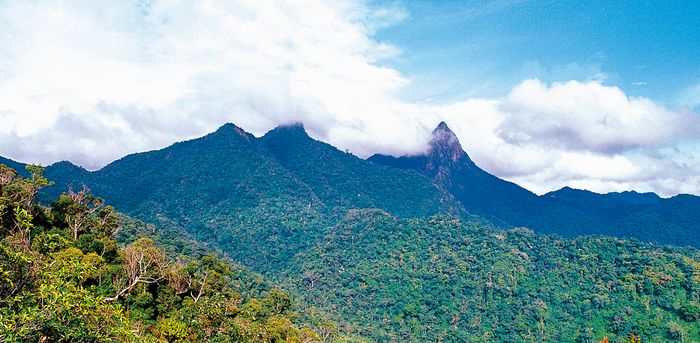Jianfengling National Forest Park, located on I the south of Hainan Island, covers a total ^ area of 447km2 and is the largest rainforest in China. From November to March, the Park receives little rainfall and its rivers and ponds dry up, waiting for the rain to come again.
The rainy season arrives in Jianfengling in June, and stays through September. The park throughout the rainy season becomes hot and humid, but no month is wetter than August. In August the rivers and ponds in Jianfengling truly come to life. As the rain comes down, it fills and refills the dry riverbed. In a single day the river can rise tens of centimeters or one meter within only several hours. The constant rain drives most of the river areas mammals out of the lowlands and up into the higher altitude alpine forest of the park. This leaves the rainforest to the insects, amphibians, reptiles and other water loving creatures.
Although the area of the river isn’t large, there are more amphibian species here than throughout China’s entire Palaearctic ecozone. This ecozone within China includes the region north of Mt. Qinling. Because the park area is relatively undisturbed, there are rare species that live and are evolving here. Two of these species are the spot-legged tree frog (Rhacophorus leucomystax) and Asiatic painted frog (Kaloulapulchra). During the dry season these frogs hide underground or under rotten wood in order to maintain the moisture in their skin. They also lower their metabolism to its bare minimum. When the rainy season starts, they drill out of the earth to begin the process of courtship and breeding.
Clusters of frog eggs are found not long after in the waters of the park and occasionally on tree branches. When temperatures reach 28 °C the eggs receive their signal to hatch, and tadpoles emerge. The time from laying to hatching is usually one week.
The emergence of the tadpoles does not go unnoticed by the other local residents. Insects and reptiles are eager to snap up the tadpoles. The back swimmers (Notonectidae), so named because they swim on their backs, perform a graceful backstroke as they capture tadpoles in the ponds, before draining them dry with their needle-like mouth. Members of the slightly larger dytiscidae family are more voracious – they eat the tadpoles bit by bit, carefully chewing each mouthful.
A master of the hunt, the South Channa (Channa gachua), is a unique carnivorous fish. This fish is a top level predator that can breathe air, and has specially designed fins that allow it to leave its pond and move across wet land to the next pond. This fish uses the rainy season to its utmost advantage.
There are many fascinating creatures that have adapted to survive in Jianfengling’s dry and rainy seasons, but it is only the rainy season that allows us to witness the relationship between organisms, land, and water.
















